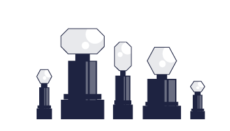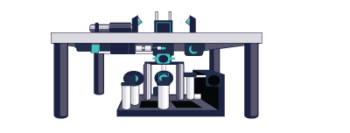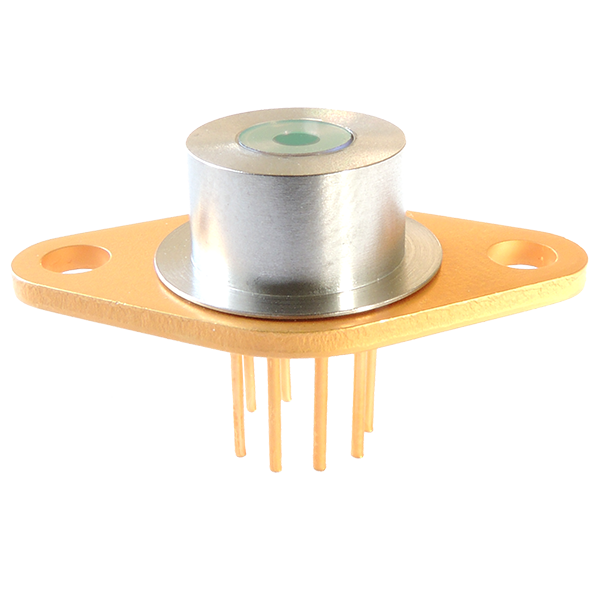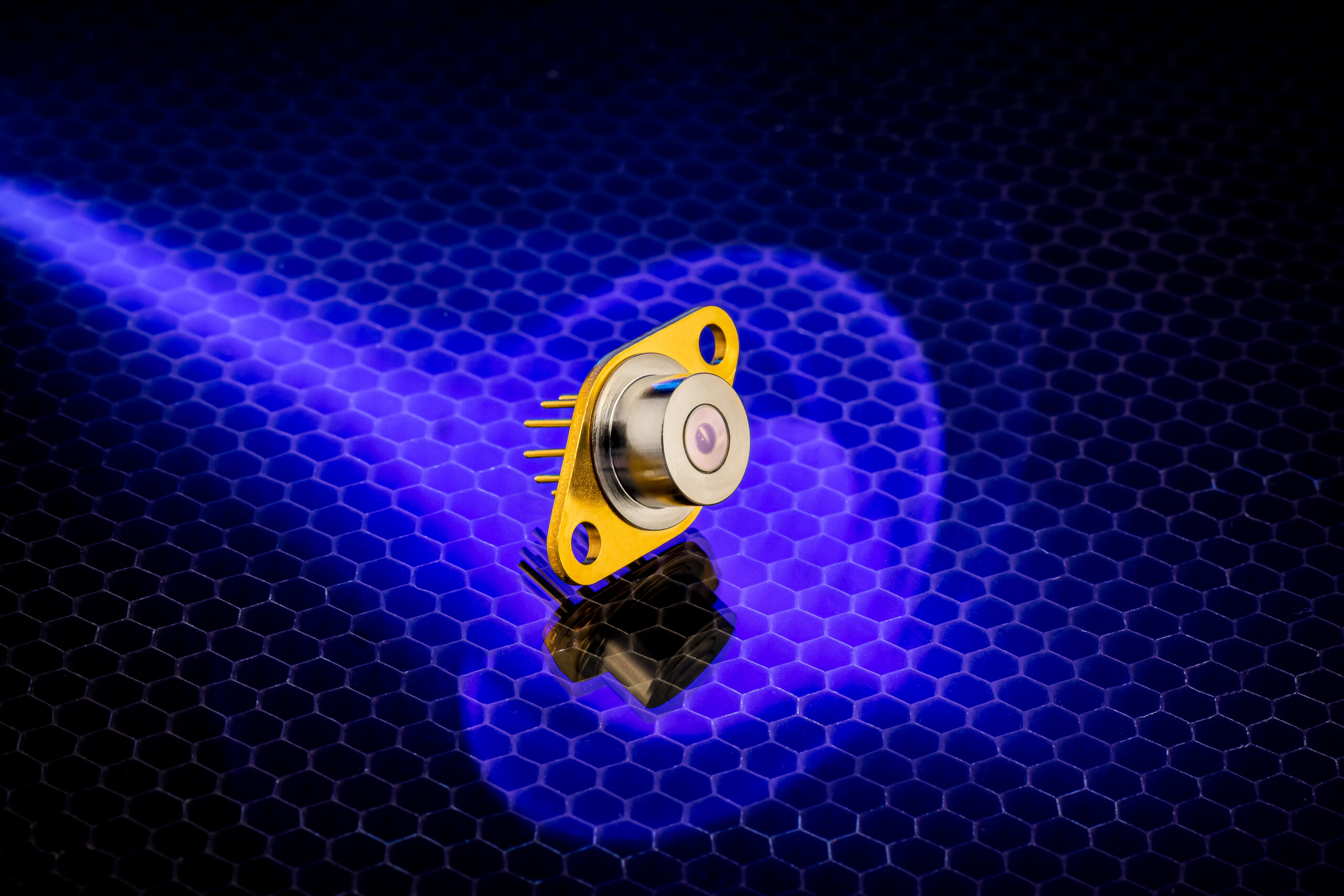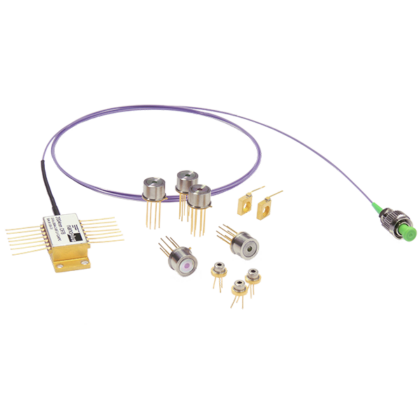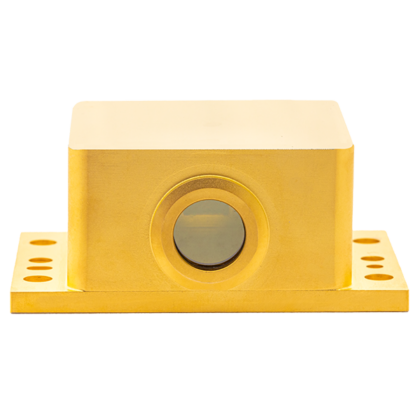Summary of typical specifications in the 2800 nm to 6500 nm range:
Top Wavelength
For wavelengths between 2800 nm and 4000 nm:
| Parameters |
Symbol |
Unit |
Min |
Typ |
Max |
| operating wavelength (at Top, Iop) |
λop |
nm |
|
0.1 nm |
|
| optical output power (at λop) |
Pop |
mW |
|
10 |
|
| operating current |
Iop |
mA |
|
120 |
|
| operating voltage |
Vop |
V |
|
5 |
|
| threshold current |
Ith |
mA |
15 |
30 |
50 |
| side mode suppression ratio |
SMSR |
dB |
|
> 35 |
|
| current tuning coefficient |
CI |
nm / mA |
|
0.10 |
|
| temperature tuning coefficient |
CT |
nm / K |
|
0.35 |
|
| operating chip temperature |
Top |
°C |
+10 |
+20 |
+50 |
| operating case temperature* |
TC |
°C |
-20 |
+25 |
+50 |
| storage temperature* |
TS |
°C |
-30 |
+20 |
+70 |
For wavelengths between 4000 nm and 4600 nm:
| Parameters |
Symbol |
Unit |
Min |
Typ |
Max |
| operating wavelength (at Top, Iop) |
λop |
nm |
|
0.1 nm |
|
| optical output power (at λop) |
Pop |
mW |
|
5 |
|
| operating current |
Iop |
mA |
|
120 |
|
| operating voltage |
Vop |
V |
|
5 |
|
| threshold current |
Ith |
mA |
20 |
40 |
60 |
| side mode suppression ratio |
SMSR |
dB |
|
> 35 |
|
| current tuning coefficient |
CI |
nm / mA |
|
0.12 |
|
| temperature tuning coefficient |
CT |
nm / K |
|
0.45 |
|
| operating chip temperature |
Top |
°C |
+10 |
+20 |
+50 |
| operating case temperature* |
TC |
°C |
-20 |
+25 |
+50 |
| storage temperature* |
TS |
°C |
-30 |
+20 |
+70 |
For wavelengths between 4600 nm and 5300 nm:
| Parameters |
Symbol |
Unit |
Min |
Typ |
Max |
| operating wavelength (at Top, Iop) |
λop |
nm |
|
0.1 nm |
|
| optical output power (at λop) |
Pop |
mW |
|
3 |
|
| operating current |
Iop |
mA |
|
120 |
|
| operating voltage |
Vop |
V |
|
5 |
|
| threshold current |
Ith |
mA |
30 |
40 |
70 |
| side mode suppression ratio |
SMSR |
dB |
|
> 35 |
|
| current tuning coefficient |
CI |
nm / mA |
|
0.14 |
|
| temperature tuning coefficient |
CT |
nm / K |
|
0.48 |
|
| operating chip temperature |
Top |
°C |
+10 |
+20 |
+50 |
| operating case temperature* |
TC |
°C |
-20 |
+25 |
+50 |
| storage temperature* |
TS |
°C |
-30 |
+20 |
+70 |
For wavelengths between 5300 nm and 5800 nm:
| Parameters |
Symbol |
Unit |
Min |
Typ |
Max |
| operating wavelength (at Top, Iop) |
λop |
nm |
|
0.1 nm |
|
| optical output power (at λop) |
Pop |
mW |
|
1 |
|
| operating current |
Iop |
mA |
|
120 |
|
| operating voltage |
Vop |
V |
|
5 |
|
| threshold current |
Ith |
mA |
30 |
40 |
70 |
| side mode suppression ratio |
SMSR |
dB |
|
> 35 |
|
| current tuning coefficient |
CI |
nm / mA |
|
0.15 |
|
| temperature tuning coefficient |
CT |
nm / K |
|
0.5 |
|
| operating chip temperature |
Top |
°C |
5 |
20 |
50 |
| operating case temperature* |
TC |
°C |
-20 |
+25 |
+40 |
| storage temperature* |
TS |
°C |
-30 |
+20 |
+70 |
For wavelengths between 5800 nm and 6500 nm:
| Parameters |
Symbol |
Unit |
Min |
Typ |
Max |
| wavelength precision |
δ |
nm |
|
0.1 |
|
| optical output power |
Pout |
mW |
|
1 |
|
| forward current |
If |
mA |
|
120 |
|
| threshold current |
lth |
mA |
30 |
40 |
70 |
| current tuning coefficient |
CI |
nm / mA |
|
0.15 |
|
| temperature tuning coefficient |
CT |
nm / K |
|
0.50 |
|
| typical maximum operating voltage |
Vop |
V |
|
5 |
|
| side mode suppression ratio |
SMSR |
dB |
|
> 35 |
|
| storage temperature |
TS |
°C |
-40 |
+20 |
+80 |
| operational temperature at case |
TC |
°C |
-20 |
+20 |
+45 |
| chip operational temperature |
Top |
°C |
+15 |
+20 |
+70 |
For wavelengths at 3345 nm:
| Parameters |
Symbol |
Unit |
Min |
Typ |
Max |
| operating wavelength (at Top, Iop) |
λop |
nm |
|
3345 |
|
| optical output power (at λop) |
Pop |
mW |
|
40 |
|
| operating current |
Iop |
mA |
|
|
120 |
| operating voltage |
Vop |
V |
|
5 |
|
| threshold current |
Ith |
mA |
15 |
25 |
40 |
| side mode suppression ratio |
SMSR |
dB |
|
> 35 |
|
| current tuning coefficient |
CI |
nm / mA |
|
0.1 |
|
| temperature tuning coefficient |
CT |
nm / K |
|
0.35 |
|
| operating chip temperature |
Top |
°C |
+15 |
+20 |
+40 |
| operating case temperature (non-condensing) |
TC |
°C |
-20 |
+25 |
+55 |
| storage temperature (non-condensing) |
TS |
°C |
-30 |
+20 |
+70 |
For wavelengths at 4565 nm:
| Parameters |
Symbol |
Unit |
Min |
Typ |
Max |
| operating wavelength (at Top, Iop) |
λop |
nm |
|
4565 |
|
| optical output power (at λop) |
Pop |
mW |
|
15 |
|
| operating current |
Iop |
mA |
|
|
120 |
| operating voltage |
Vop |
V |
|
5 |
|
| threshold current |
Ith |
mA |
20 |
30 |
40 |
| side mode suppression ratio |
SMSR |
dB |
|
> 35 |
|
| current tuning coefficient |
CI |
nm / mA |
|
0.12 |
|
| temperature tuning coefficient |
CT |
nm / K |
|
0.45 |
|
| operating chip temperature |
Top |
°C |
+15 |
+20 |
+40 |
| operating case temperature (non-condensing) |
TC |
°C |
-20 |
+25 |
+55 |
| storage temperature (non-condensing) |
TS |
°C |
-30 |
+20 |
+70 |










